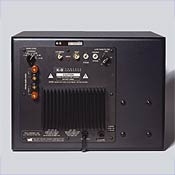Subway Series Page 3
But lab measurements tell you only so much. It's how they perform in a home theater that matters, and both proved to be true-blue subs there, too. They handled "bass-head" CD tracks -- like "976-BASS" from Bass Erotica's Bass Ecstasy (Neurodisc) and Bass Connection's "Pure and Perfect Bass" from Drivin' Bass (Neurodisc) -- with aplomb, if not plaster-shattering SPL. They also did well by below-20-Hz material, like the opening organ pedal of Thus Spake Zarathustra from DVD Space Spectacular (Delos) and "Jurassic Lunch" from Telarc's The Great Fantasy and Adventure Album.
Both of the Infinity subs also rumbled with authority when I took them for a ride with demanding DVD soundtracks like the subway scenes in The Matrix (Chapter 33) and End of Days (Chapter 17), although the Interlude had 3 to 6 dB less output at 25 Hz (as measured with my sound-level meter). On Zarathustra's sustained organ note, the Interlude sometimes sounded slightly louder than it measured because it overemphasized the tone's second harmonic. But it did manage to keep port noise well in check, which is no small feat.
The Intermezzo's admirable tendency to distribute its acoustic output evenly across its bandwidth (most subs have more output at the higher frequencies) meant that it delivered more power to the bottom octaves than many other subwoofers in its class. What does that mean for you? Lots of chest-pounding bass that will envelope you when the program material calls for it and a chance to actually hear the true glory of a sustained organ pedal such as Zarathustra's 16-Hz tone.
M&K K-9 and MX-125 Mk II
 Like Mutt and Jeff, the M&K entries are the largest and the smallest subs to attend our little party. The diminutive K-9 weighs just 22 pounds and will take up less than a cubic foot of your living space, while the MX-125 Mk II weighs 67 pounds and occupies over 4 cubic feet. (Note that my cabinet measurements include connectors, knobs, and amplifier heat sinks -- like the monster that protrudes 2 inches from the rear of the larger M&K sub.)
Like Mutt and Jeff, the M&K entries are the largest and the smallest subs to attend our little party. The diminutive K-9 weighs just 22 pounds and will take up less than a cubic foot of your living space, while the MX-125 Mk II weighs 67 pounds and occupies over 4 cubic feet. (Note that my cabinet measurements include connectors, knobs, and amplifier heat sinks -- like the monster that protrudes 2 inches from the rear of the larger M&K sub.)
The MX-125 Mk II's cabinet holds a pair of 12-inch push-pull drivers, with one behind the grille and the other mounted at the bottom of the enclosure. Push-pull driver mounting is said to reduce harmonic distortion by canceling driver nonlinearity, but the real advantage of dual drivers is that they move twice as much air.
The MX-125 has the most limited feature set in the group, with only a line-level input and no outputs of any kind. The K-9 has both line- and speaker-level inputs as well as speaker-level outputs. Both have crossover bypass switches, but there's nothing about their crossover facilities to keep most folks from using them in a home theater system. Both also have very steep crossover slopes of around 36 dB per octave and, as with the Infinity subs, the dial markings closely matched the actual crossover response. The calibrated level-control indicators proved to be surprisingly accurate, too.
The K-9's single 8-inch driver had remarkably good bass extension for its size, but, as you'd expect, its dual-driver big brother played a lot louder and went a lot lower -- all the way down to 20 Hz. In fact, with music or movies, I didn't notice any difference between the two subs unless there was a lot of deep bass. I could always count on the MX-125 Mk II for a good rumble, while on a lot of the same material -- like the soul-rattling roar that opens Chapter 18 of End of Days -- the K-9 just ran out of steam. But a small sub that can go down to at least 25 Hz, if meekly, is certainly better than no sub at all. Monitoring the SPL with movies revealed that the K-9 had between 3 and 12 dB less output below 50 Hz, depending on its overall level. At times, the K-9 had trouble keeping up with my main speakers' 61¼2-inch woofers. As the middle and high frequencies were increasing in level, the bass stayed put, which shifted the tonal balance of the entire system upward. For instance, when I turned up the volume on Quincy Jones's "The Places You Find Love" from Back on the Block (Warner Bros.), the percussion took on a "tonk tonk" quality. And on programs with truly Herculean bass, such as the bass-head tracks, the K-9 went into gross overload, forcing me to turn the volume way down.
The MX-125 Mk II couldn't handle those tracks at top volume either -- nor could any of the other subs here -- but I could play them at healthy peak room levels of around 100 dB without audible noise or distortion. The MX-125 took a decent stab at the 16-Hz organ fundamental in Zarathustra. While it couldn't do full justice to the fundamental tone, it did a fine job with the second harmonic, bested only by the Infinity Intermezzo and the Velodyne SPL-1200. It's not every day you hear a true 32-Hz note in your listening room -- many people wouldn't even notice that the fundamental was missing.









































